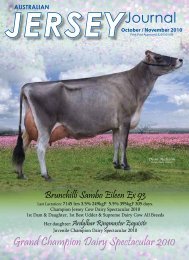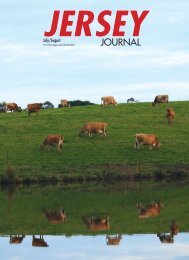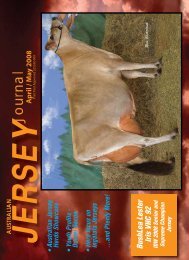Australian Dairy Herd Improvement Report 2010.pdf
Australian Dairy Herd Improvement Report 2010.pdf
Australian Dairy Herd Improvement Report 2010.pdf
You also want an ePaper? Increase the reach of your titles
YUMPU automatically turns print PDFs into web optimized ePapers that Google loves.
Partner Project<br />
Mastitis Focus <strong>Report</strong><br />
MACALISTER RESEARCH FARM<br />
PO BOX 87<br />
MAFFRA, 3860<br />
Your <strong>Herd</strong><br />
Trigger<br />
Mastitis Focus reports can be generated for herds<br />
using the common herd management software<br />
(such as Mistro Farm and Easy <strong>Dairy</strong>) or herd<br />
recording data systems in Australia.<br />
The Mastitis Focus report is a great value-add to<br />
those investing in herd recording. It uses individual<br />
cow cell counts to describe how quickly infection<br />
is spreading to clean cows in the herd. A high ‘New<br />
Infection Rate’ often precedes an increase in clinical<br />
cases – and taking early action can help avert a<br />
clinical case outbreak.<br />
V 1.1015<br />
<strong>Report</strong> period: 01.11.09 - 31.10.10<br />
Total calvings: 306<br />
<strong>Herd</strong> test cell count: 161<br />
YOUR HERD ANNUAL PERFORMANCE SUMMARY<br />
Clinical Case Rates<br />
Calving Lactation<br />
0<br />
cases per 100<br />
cows calved<br />
1<br />
cases per 100 cows<br />
in milk per month<br />
>5 >2<br />
New Infection Rate<br />
Subclinical & Clinical<br />
Your <strong>Herd</strong><br />
Trigger<br />
3<br />
cases per 100 cows<br />
in milk per month<br />
>5<br />
<strong>Herd</strong> ID: 703293<br />
Printed: 08.12.2010<br />
<strong>Herd</strong> Milk Cell Counts<br />
Average cell count at the<br />
4 most recent tests<br />
18.10.10 161<br />
10.05.10 166<br />
04.03.10 91<br />
06.01.10 73<br />
Queries around clinical case treatment<br />
effectiveness, the numbers of recurring cases and<br />
the levels of mastitis at calving were high on the list<br />
of concerns for farmers participating in the industry<br />
consultation (see Figure 2). Mastitis Focus reports<br />
these parameters for farms that enter Lactating Cow<br />
Treatments into the herd management software.<br />
However, this information is currently only able to<br />
be assessed for about 10% of herds because the<br />
data is not entered into the computerised herd<br />
records despite all farmers keeping these (usually<br />
paper-based) records as part of their quality<br />
assurance programs.<br />
<strong>Dairy</strong> veterinarians have a good grounding in the<br />
principles of clinical case management and are able<br />
to help farmers develop protocols and reduce the<br />
risk of ‘outbreaks’ in their herds.<br />
Currently, about 100 Mastitis Focus reports are being<br />
generated from the web per month. To increase its<br />
use, industry needs to promote the flow of clinical<br />
case data into the system and Countdown needs to<br />
help dairy advisers become more familiar with the<br />
report and confident in recommending its use.<br />
KEY MANAGEMENT AREAS IN FOCUS<br />
Your calving system<br />
Clinical mastitis<br />
10<br />
5<br />
0<br />
Monthly clinical case rate at calving (all cows)<br />
When cases occurred<br />
N D J F M A M J J A S O<br />
First calver<br />
clinical case rate<br />
Your <strong>Herd</strong><br />
0<br />
cases per 100<br />
first calvers<br />
Trigger<br />
>5<br />
Trigger<br />
5<br />
cases<br />
per<br />
100 cows<br />
calved<br />
Monthly clinical case rate in lactation (all cows)<br />
When cases occurred<br />
10<br />
Trigger<br />
2<br />
5<br />
cases<br />
per<br />
100 cows<br />
in milk<br />
0<br />
N D J F M A M J J A S O<br />
Total<br />
clinical cases<br />
Treatment failure<br />
Cases with an extended treatment<br />
Your <strong>Herd</strong><br />
24 cases<br />
Your <strong>Herd</strong><br />
4%<br />
Trigger<br />
>20%<br />
Spread of infection<br />
10<br />
5<br />
0<br />
First calver<br />
new infection<br />
Indicates the extent<br />
of spread<br />
Your <strong>Herd</strong><br />
11%<br />
Trigger<br />
>15%<br />
Average new infection rate (all cows)<br />
When clean cows became infected<br />
N D J F M A M J J A S O<br />
Culling to control mastitis<br />
Cows prone to<br />
clinical mastitis<br />
Cows in herd with 3 or more<br />
clinical cases in a lactation<br />
Cows infected in<br />
multiple lactations<br />
Cows still infected after<br />
2 consecutive prior lactations<br />
despite intervening DCT<br />
Star rating<br />
Your <strong>Herd</strong><br />
2 cows<br />
?<br />
Trigger<br />
5<br />
cases<br />
per<br />
100 cows<br />
in milk<br />
?<br />
Trigger<br />
Any Cows<br />
Any Cows<br />
Previous dry-off strategies<br />
Failure to cure over the dry<br />
Existing infections not cured by<br />
antibiotic Dry Cow Treatment<br />
Missed treatments<br />
Infected cows that didn't receive<br />
antibiotic Dry Cow Treatment<br />
Infections over the dry<br />
Cows that became infected<br />
in the dry-off or at calving<br />
Dry period clinical case rate<br />
Indicates the success of the<br />
dry-off procedure<br />
Your <strong>Herd</strong><br />
?<br />
?<br />
14%<br />
Plan your next drying-off<br />
Only consider a<br />
selective DCT strategy when:<br />
You have 4 or more cell counts for each cow<br />
Strep ag is not present in your herd<br />
(based on milk culture results)<br />
Less than 30% of cows had high cell counts<br />
Your clinical case rate at calving was less than 5<br />
?<br />
Trigger<br />
>20%<br />
>5%<br />
>10%<br />
?<br />
>1<br />
case per 100 cows<br />
Your <strong>Herd</strong><br />
Yes<br />
See your vet<br />
No<br />
Yes<br />
Consistently below trigger points Opportunity to reduce risk Seek professional advice Insufficient records<br />
?<br />
Figure 3: You can practise generating this Mastitis<br />
Focus test report or try with a file from a client’s<br />
farm.<br />
• Download the Macalister Research Farm file onto<br />
your computer from http://www.dairyaustralia.<br />
com.au/Farm/Mastitis-and-milk-quality/<br />
Mastitis-Focus.aspx<br />
• Go to www.mastitisfocus.com.au then follow the<br />
prompts and load the Macalister zip file. If you<br />
want your report to exactly match the report on<br />
the left, enter the report date as 31/10/2010.<br />
• PDFs of the generated reports will then appear as<br />
links that you can click on and will also be sent to<br />
your nominated e-mail address.<br />
14 <strong>Australian</strong> <strong>Dairy</strong> <strong>Herd</strong> <strong>Improvement</strong> <strong>Report</strong> 2010

















